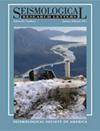为什么新西兰奥特亚罗瓦断层很少发生 "超期 "大地震?
IF 3.2
3区 地球科学
Q2 GEOCHEMISTRY & GEOPHYSICS
引用次数: 0
摘要
了解地表破坏性地震的时间模式对于地震灾害评估至关重要。我们通过整理新西兰奥特亚罗瓦地区古地震和历史记录中的经过时间和重现间隔数据,研究了这些模式。我们发现,在取样的大于 50 个断层中,大多数断层(70% ∼ 80%)自上次地震以来的历时小于平均重现间隔。利用这些断层的每次滑移量和滑移率计算出的平均重现间隔并不表明古地震重现间隔数据集因缺失地震而出现系统性偏差。经过时间的随机建模表明,经过时间大于平均重现间隔的情况非常罕见,这与正偏斜的 Weibull 和对数正态重现间隔模型是一致的。无论对短间隔时间的精确解释是什么,所采样的大多数断层都不可能在其地震周期中长期处于晚期。本文章由计算机程序翻译,如有差异,请以英文原文为准。
Why Do Large Earthquakes Appear to be Rarely “Overdue” for Aotearoa New Zealand Faults?
Understanding temporal patterns of surface‐rupturing earthquakes is critical for seismic hazard assessment. We examine these patterns by collating elapsed time and recurrence interval data from paleoseismic and historical records in Aotearoa New Zealand. We find that the elapsed time since the last earthquake is less than the mean recurrence interval for the majority (∼70%–80%) of the >50 faults sampled. Calculated mean recurrence intervals using slip per event and slip rate for these faults do not indicate systematic bias of the paleoseismic recurrence‐interval dataset due to missing earthquakes. Stochastic modeling of elapsed times indicates that the rarity of elapsed times greater than the mean recurrence interval is consistent with positively skewed Weibull and lognormal recurrence‐interval models. Regardless of the precise explanation for the short elapsed times, the majority of faults sampled are unlikely to be chronically late in their seismic cycles.
求助全文
通过发布文献求助,成功后即可免费获取论文全文。
去求助
来源期刊

Seismological Research Letters
地学-地球化学与地球物理
CiteScore
6.60
自引率
12.10%
发文量
239
审稿时长
3 months
期刊介绍:
Information not localized
 求助内容:
求助内容: 应助结果提醒方式:
应助结果提醒方式:


